When I started this journey with my blog, RALPH’S TREK (http://ralph-senensky.blogspot.com/2009/09/welcome-to-my-blog.html) in 2009, I really didn’t have a definite idea of what I wanted to achieve. What I did know however was what I didn’t want my blog to be! I had recently read an autobiography by a fellow director, who also happened to be a friend. His memoir was filled with places he visited, restaurants where he had dined. It seemed almost like a collection of entries from a diary he had kept. Frankly I didn’t find it interesting. For my project I thought, why not just write about the television shows I had directed. And that’s what I did for the next year and a half. By then the size of the TREK outgrew its blog capabilities. With professional help the blog was turned into a website and with a new name: RALPH’S CINEMA TREK (http://senensky.com/) By then, as I was no longer indefinite about what I wanted my website to be, I wrote an invitation: on my Home Page:
So … how about hopping aboard, pull up a chair beside me at the moviola as I take you onto the sets where all of this occurred.
And again that’s what I did, but sometime later, and I can’t explain why, I published 2 posts on Somerset Maugham’s THE CIRCLE, the first play I directed on the main stage of the Pasadena Playhouse. That was followed sporadically over a period of time by posts of 4 other plays I had directed before JOHNNY TEMPLE, my first directed film — all with a faint tinge of guilt for having veered from my proclaimed aims. But now as I rapidly approach completing another year’s distance from that period I’m writing about, I find my perception has changed. Do perceptions change just as eyesight changes with advancing years? I once had those theatre posts listed under the category: …BUT I’M STILL HERE. I have now changed that category to: THE EARLIER TREKS.
The journey for THE ADDING MACHINE (1952), the stage production I’m writing about now, began quite a bit earlier. It was 1947, I was 24 years old and I was in my first year at the Pasadena Playhouse School of Theatre. One of my classes was the use of background music in theatre production. The professor was Margot Poley, who also served as Director of Admissions for the school. During the term each member in the class had to participate in a project involving drama and music. One of my classmates, Richard Vath, and I decided we would do a scene from Daphne du Maurier’s REBECCA. I would prepare a cutting from the novel, plot the music and direct; Richard would play Maxim and we invited a lovely actress in the class, Annabel Hirsch, to play the young Mrs. De Winter. The scene started with Mrs. De Winter standing downstage left saying, “Last night I dreamt I went to Manderley again” (the first words in both the novel and the film). She continued, telling of events that led into a climactic enacted scene when Maxim admits to killing his first wife, Rebecca. The scene was about 15 minutes long and as I remember, I had music planned for the entire 15 minutes. I don’t remember all of the music or where I obtained it, but I do remember starting with Addinsell’s Warsaw Concerto. After much, much rehearsing our project was presented before the class in one of the Balcony theatres with me offstage at the turntable playing the recorded music. When the scene ended, lights came on in the small auditorium and Thomas Browne Henry, dean of the school, was standing in the aisle. Ms. Poley, seeing him asked, “Thom, when did you come in?” He responded, “Just now.” Ms. Poley then said (her voice tinged with disappointment) “Oh, Thom!”
Early in my second year I was assigned to work on instructor/director Fred Berest’s student production of Elmer Rice’s THE ADDING MACHINE. THE ADDING MACHINE was a landmark of American Expressionism, a highly subjective, nonrealistic form of modern drama. Mr. Berest asked me to prepare the background music for the production. Was there a connection between the project in Poley’s class and his request? I suspected there was. Each of the play’s 7 scenes required different music backgrounds. I don’t remember where I found the music, but I do remember the driving force of one of my selections — a thundering cacophony that I used as the main musical theme of the production. During our 10-day run I ran the turntable for every performance. It must have been a success. Another instructor/director made the same request of me on one of my later assignments that year.
Which brings us to 1952 in Mason City, Iowa. It was near the end of my 2-year stint as director for Mason City Little Theatre and I had selected THE ADDING MACHINE as the 4th of the 5 scheduled productions. Obviously I knew the play well; I still had the recordings I had made of the background music and there had been something important missing in that student production. Of necessity student productions were produced on limited sets with gray walls and gray block furniture. I wanted to direct a production that was vividly theatrical, exciting, dazzling, presenting visually the bold expressionism that couldn’t be attempted in that student production. Quite a goal for a 28-year old with a non-professional cast, less than limited facilities to produce the sets, all this on the high school stage with outdated lighting equipment and this was only his 10th directed production. You know what this nonagenarian would say to that 28-year old? Kid, boy do you have chutzpah!
Dictionary: chutzpah – Late 19th century Yiddish
shameless audacity, impudence, cheek, guts
The most important part of my scenery was a 21-foot high by 30-foot wide scrim of an adding machine. If you had the space, the material would be hung so that it could be raised and lowered as it was being painted. We didn’t have such a place. This was going to be painted the same way the flats for my preceding 7 Little Theatre productions had been painted – laid out flat on saw horses in the back area of my dad’s jewelry store. The amazing Milllie Chorak, who had designed all of my Little Theatre sets, created the design, then sketched it out section by section on this monstrous piece of material, and painted it section by section; so when the play started, the stage curtain rose with the cacophony music blaring to reveal this:
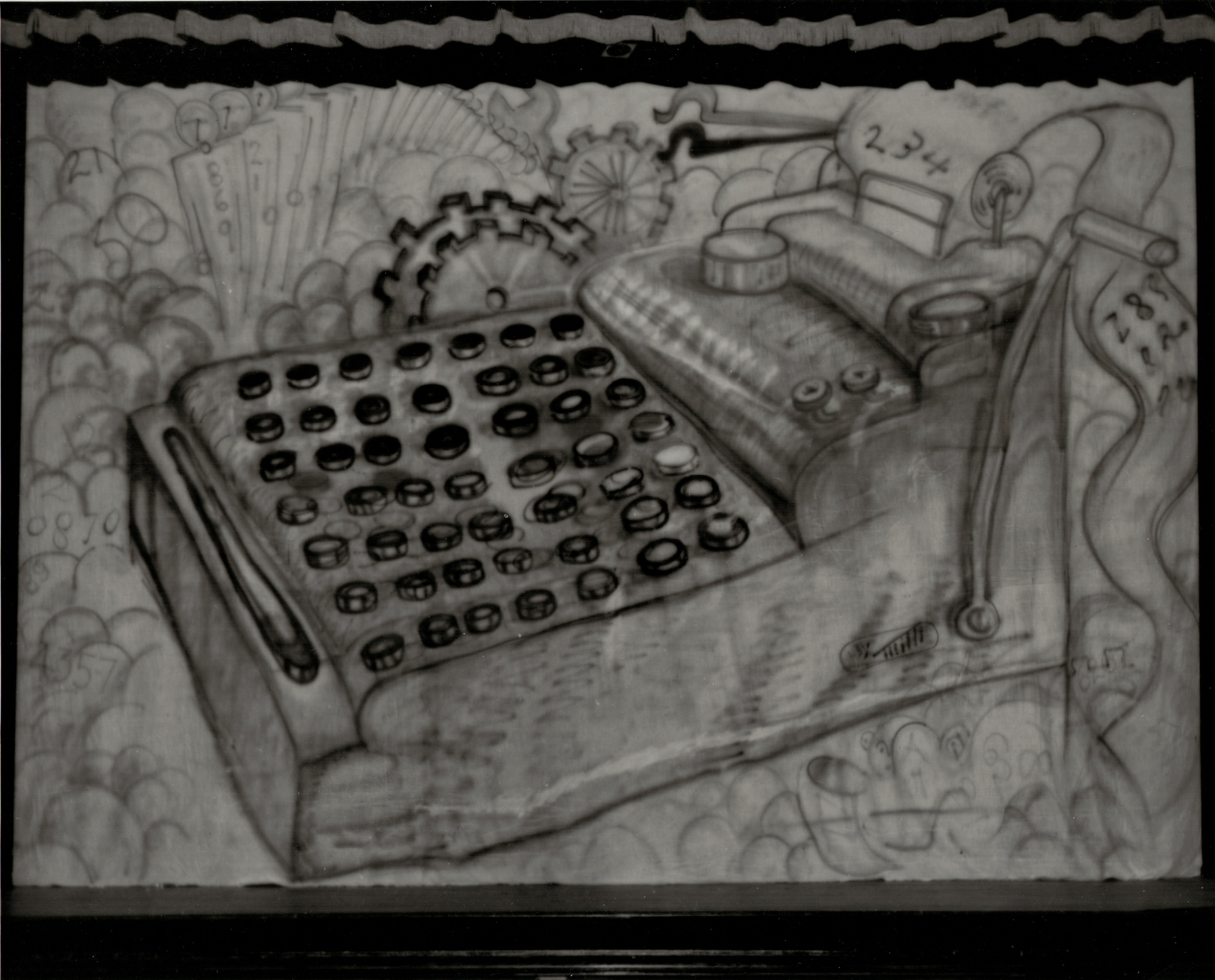
(The photo was shot during the final dress rehearsal performance. The photo is black and white, as are all of the photos you will see. Millie’s painting of all the sets was full color.)
The adding machine curtain then rose to reveal the first scene.
After 6 weeks of rehearsing the cast of 21 actors in a rehearsal space, we were ready to move scenery and cast to the Mason City High School stage for 3 days of the technical work preceding our Thursday night opening. The first scene in the play found Mr. Zero in bed, silent, as his wife berates him with a vicious diatribe. I had cast Rosemary Darland, who had played Lola earlier that season in COME BACK, LITTLE SHEBA, as the wife. Sunday, the day before our move, I received a phone call telling me she was ill and would not be able to perform. I called my friend, Ruth Sternhill, who had appeared in 2 of my productions. She agreed to step in, came to Sunday’s final pre-move rehearsal and in the following 3 days during the technical rehearsals, she got herself up in the very long opening monolog.
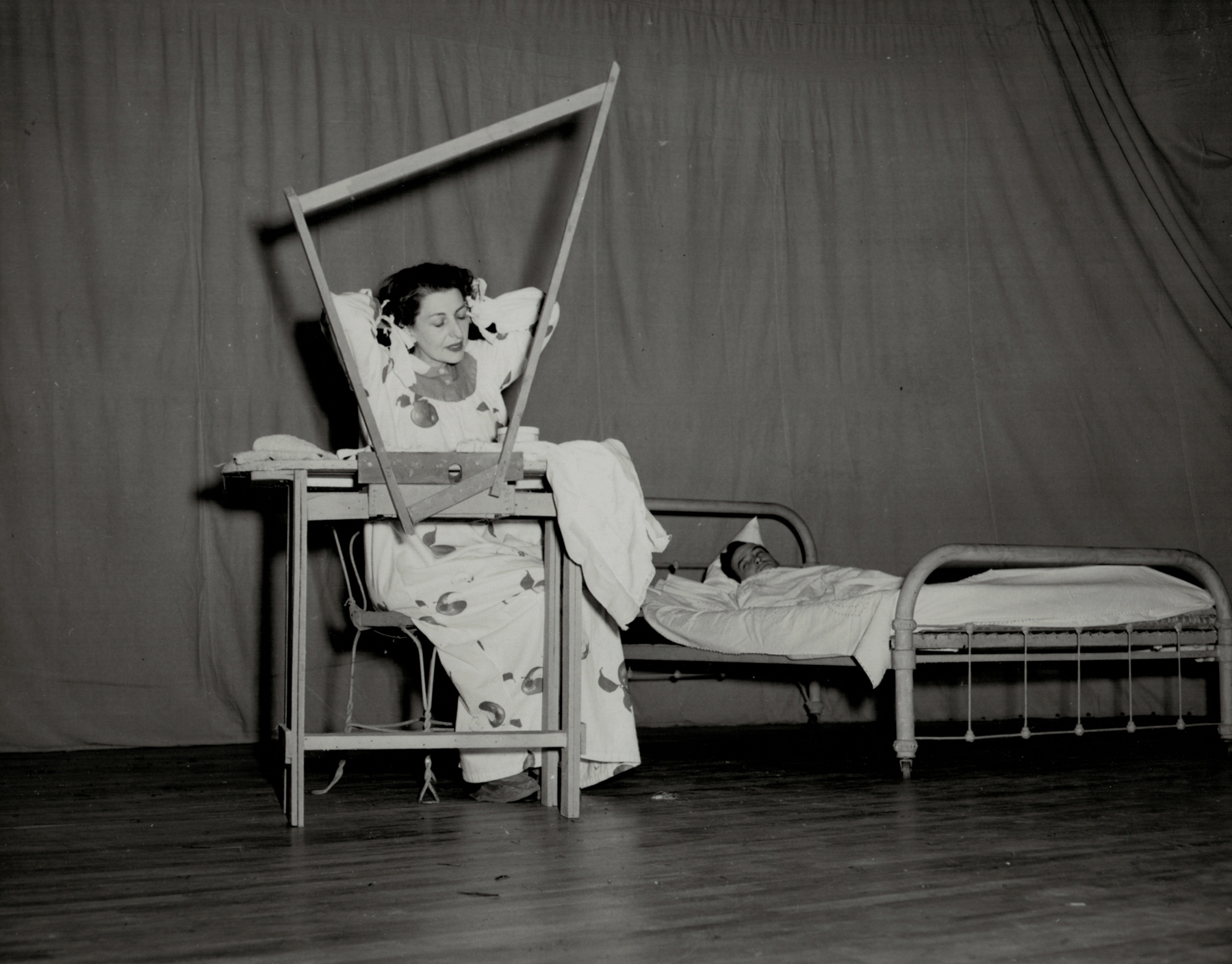
As I stated above, the lighting equipment for the theatre was outdated. There was a bank of footlights (3 circuits: red, blue, green, each on a dimmer); a bank of borders (again 3 circuits: red, blue, green, each on a dimmer) and 9 spotlights. As I remember, the 2 giant spotlights hung in the second balcony were on dimmers, but there were no dimmers for the other 7 spotlights! As I had done on previous productions, I plugged the spotlights into outlets of the border. Tuesday, our 2nd day of tech, Warren Ruby, art teacher in the high school and supervisor in charge of the theatre auditorium, told me we couldn’t do that. It was overloading those circuits. I was stunned, but knew he was right. You’ve all heard of Murphy’s law: “Anything that can go wrong will go wrong.” This was Murphy’s law on steroids!
I already knew that off stage right there were two high-powered circuits under the stage floor, each with a heavy-duty cable that plugged into it. Each cable had a box at the other end with, as I remember, 4 outlets for plug-ins. These circuits were connected to the main lighting board and could be switched on and off, but not dimmed. We then ran the cables of the 7 spotlights spaced around the stage to the right stage area with the power circuits. Each spotlight cable was given a number written on an attached tag. They couldn’t all just be plugged in because not all of them worked at the same time. A cue sheet was made as to which cables needed to plugged in for each scene. Paul and Harvey, my two teenage cousins, were put in charge. That’s how we plunged on and we did open as planned on Thursday night.
After Mrs. Zero’s first scene harangue, the adding machine curtain descended, a worktable was wheeled on stage and the play continued with Mr. Zero and Daisy at work.
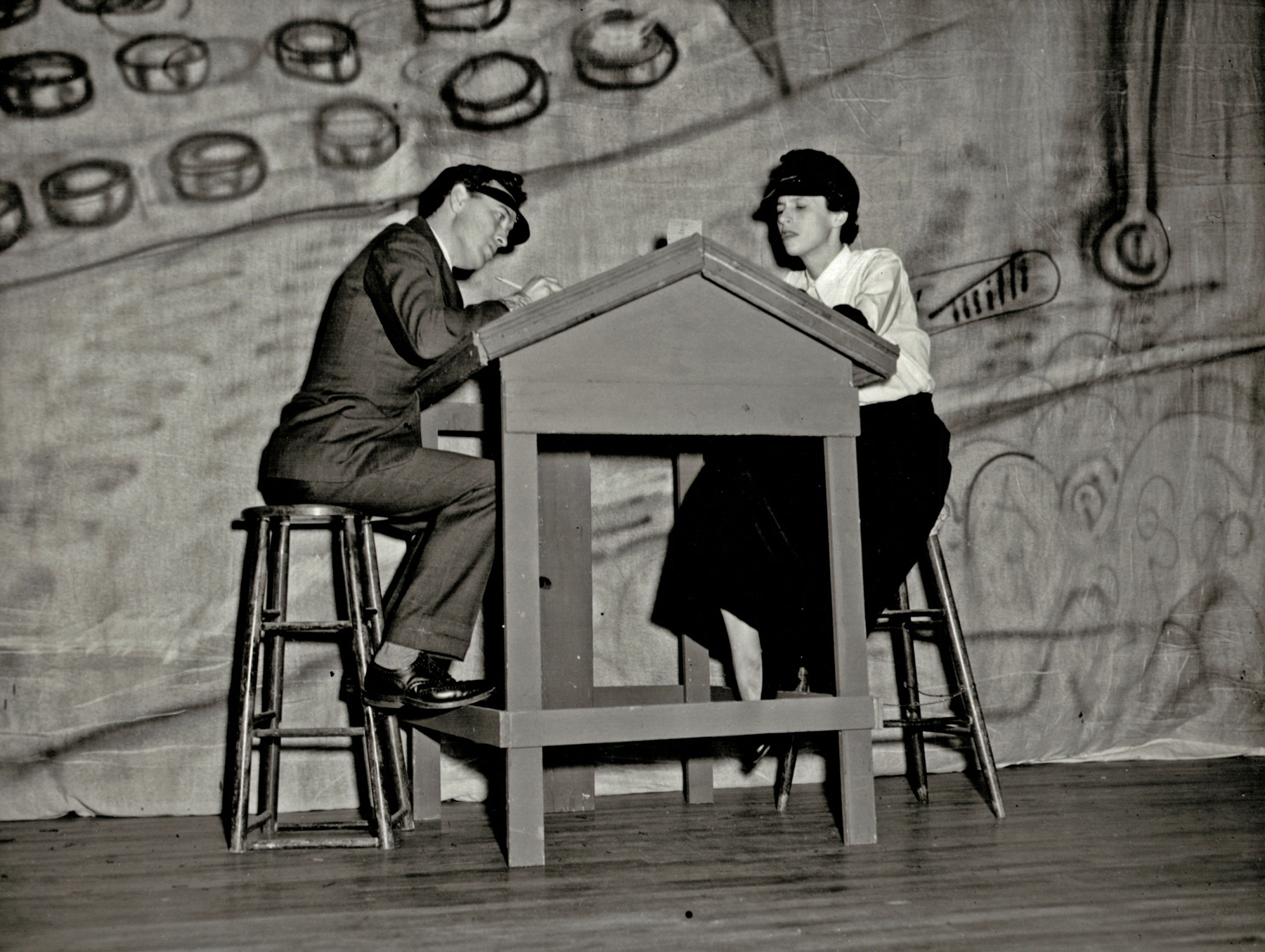
Mr. Zero (and that describes him in his capabilities, achievements et al) plugs on, unaware that Daisy is in love with him. She leaves and Mr. Zero’s boss enters.
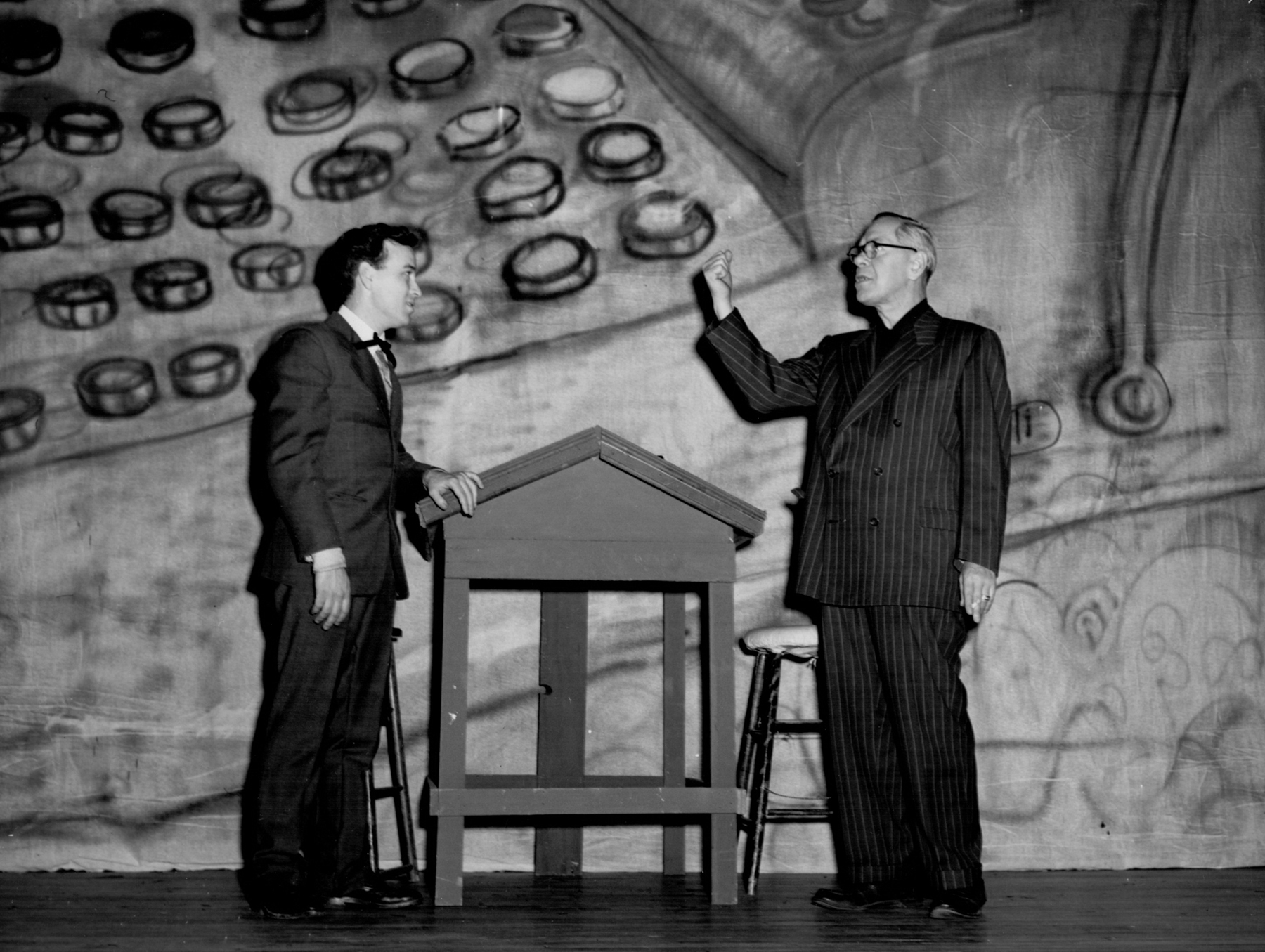
Let me take a moment to introduce the cast. Mr. Zero was played by Steve Stahl, who had appeared the year before as the killing Danny in NIGHT MUST FALL (http://senensky.com/night-must-fall-1951/). The boss was played by Doc Jones, a local dentist who had appeared the year before in my production of Ruth Gordon’s YEARS AGO. They were really part of what I considered my Mason City Little Theatre stock company.
An argument ensues between boss and employee resulting in Mr. Zero’s killing his employer. BLACKOUT. The worktable is rolled offstage, 12 people and Mrs Zero, bringing their own chairs, come on stage in the blackout and lights go up so we can meet Elmer Rice’s outrageous hypocrites.

Milllie Chorak’s contributions didn’t end with the Adding Machine curtain. She designed set pieces for all the following scenes, others built them and she painted them, starting with the items for Mr. Zero’s trial.
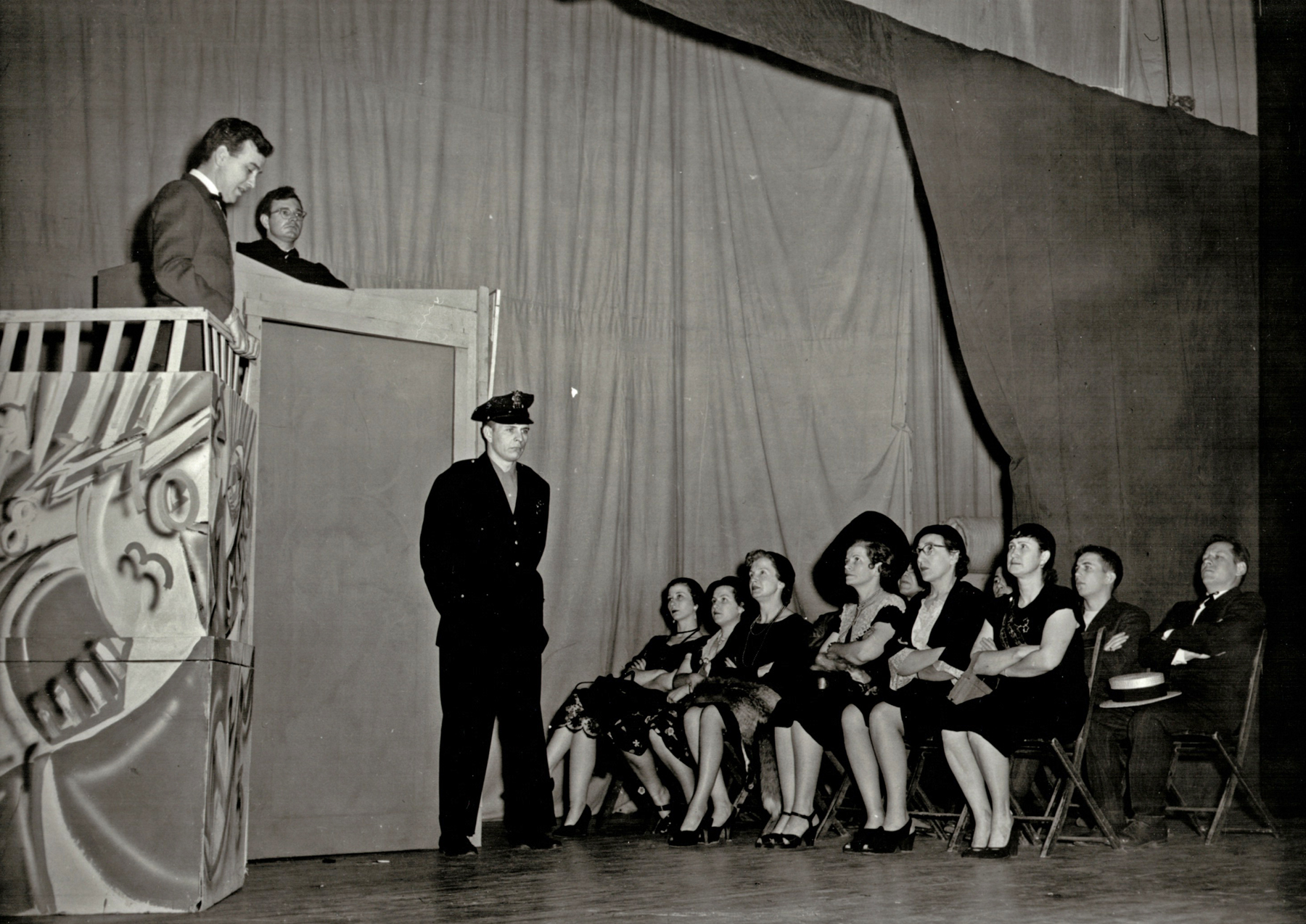
Mr. Zero is found guilty so we next find him in a Millie Chorak-designed cemetery with a strange fellow-corpse companion, Shrdlu.
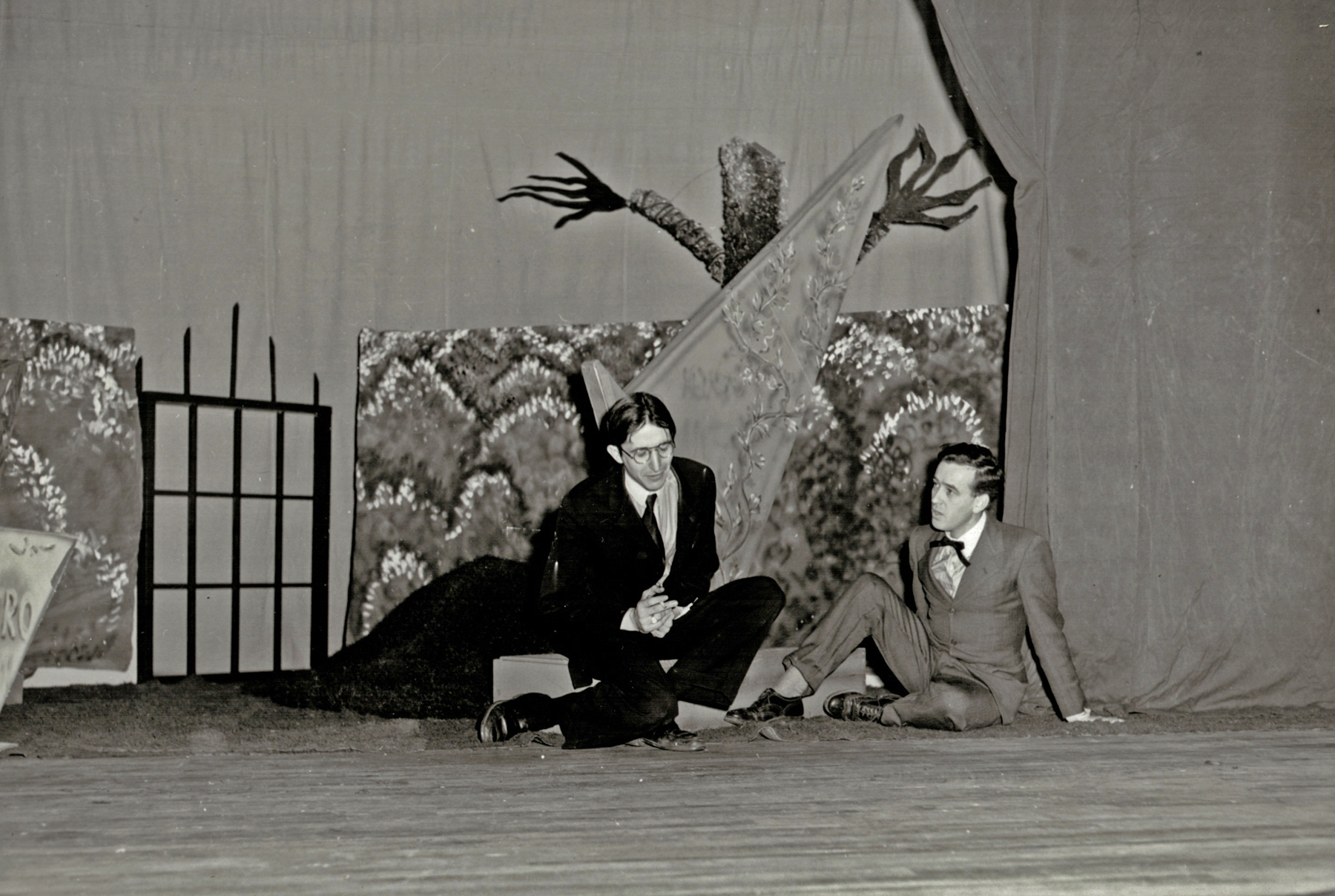
His next stop is the Elysian Fields, where he finds Daisy, who has also died.
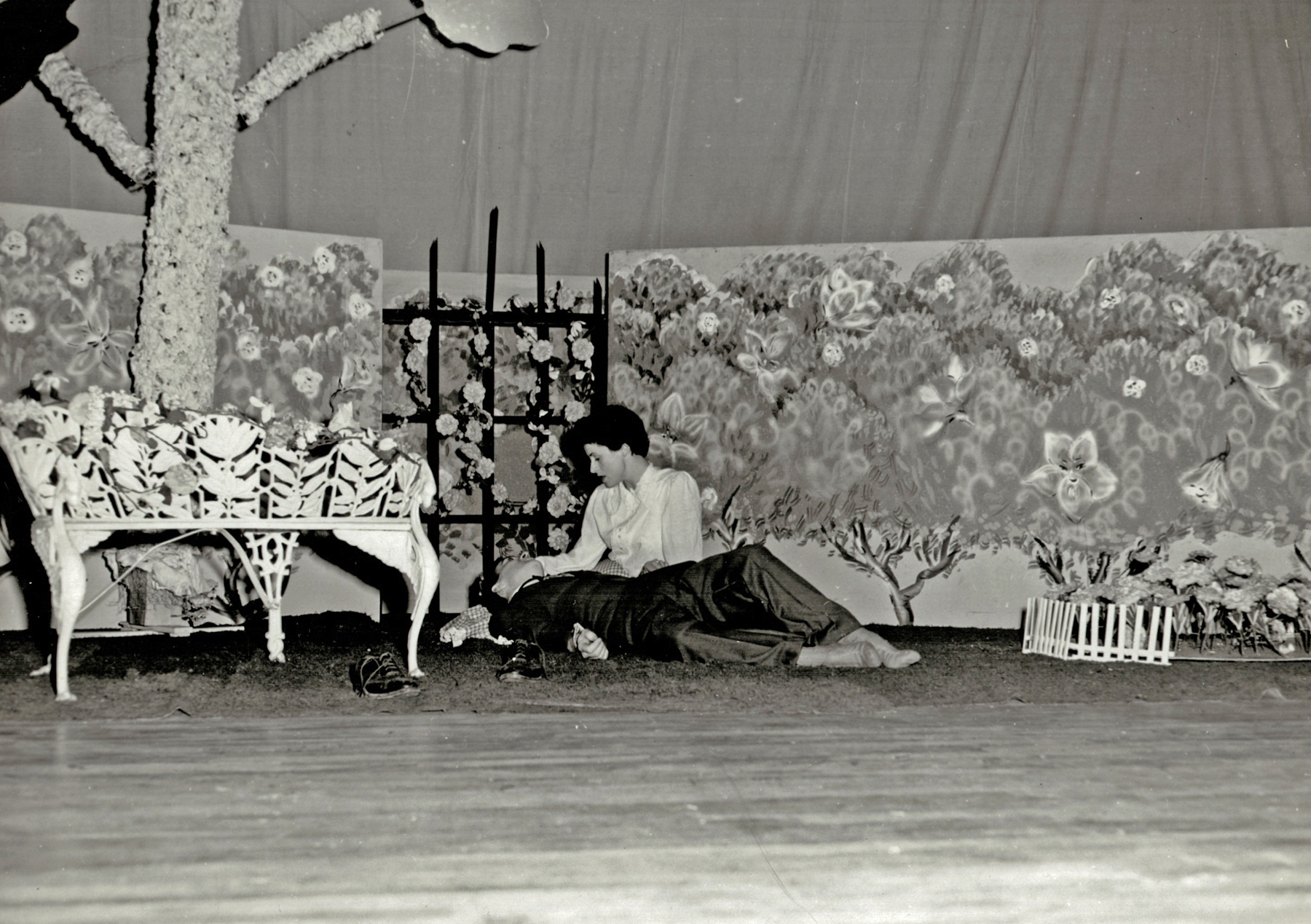
I wish you could see these photos with the painted sets and colored lighting!
But Mr. Zero’s destiny is not going to be the Elysian Fields. His next and final stop is Purgatory. And here I again used my Adding Machine scrim curtain but differently.
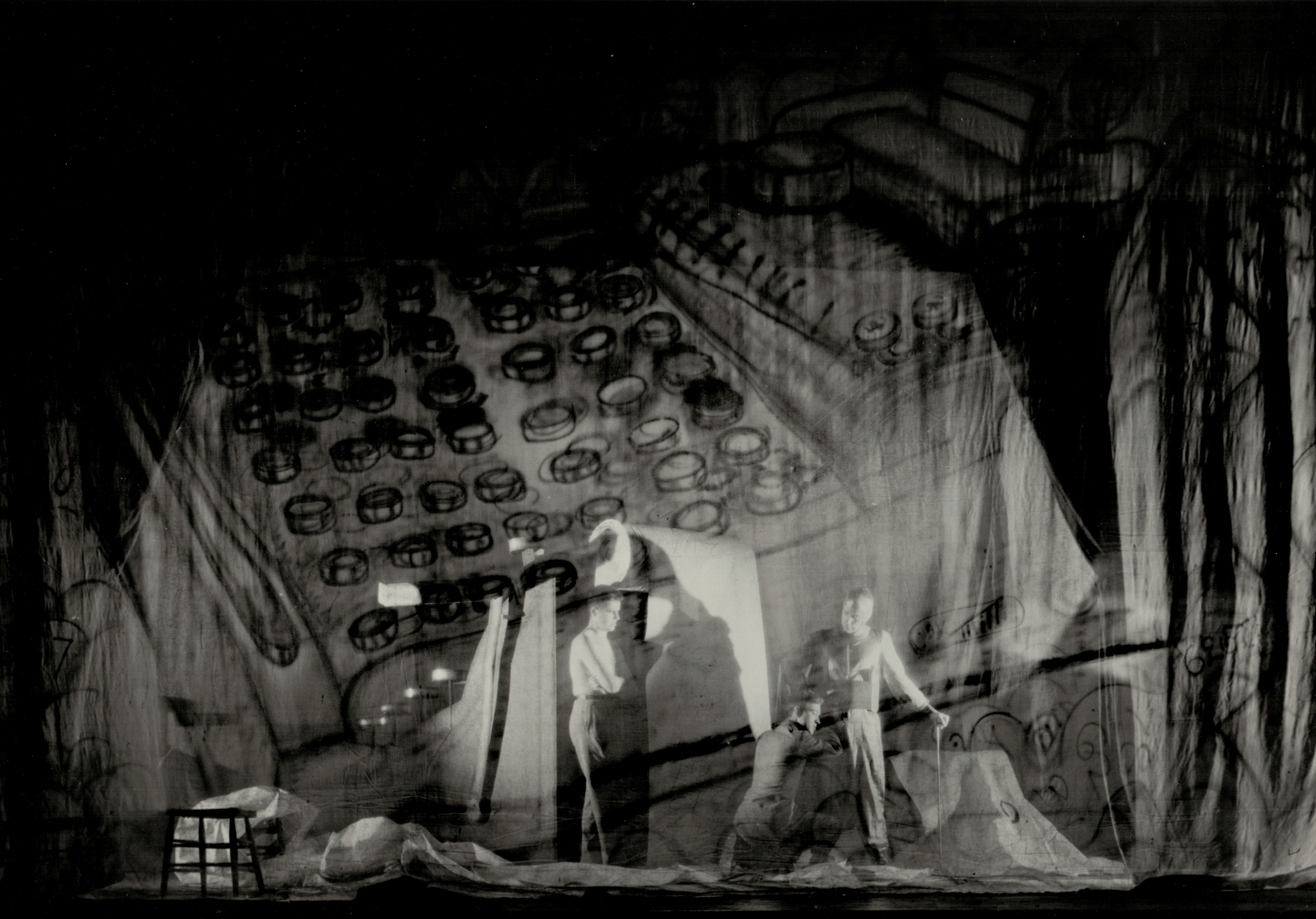
The young lad at the left was my cousin Paul who was doing double duty. The devil was another member of my stock company, Bill Minshall, who had previously appeared in ARENIC AND OLD LACE and CLAUDIA.
At this point I could editorialize and discuss what I learned from this experience, how this production helped me grow as a director, but I won’t. I think the facts speak for themselves. And as Jack Webb used to say on DRAGNET, “Just the facts, ma’am, just the facts.” But I will refer again to something Frayne Williams, one of my instructors at the Playhouse said: “Great art is a sublimation of limitations.” I don’t think what I accomplished was great art. But I definitely think it was a sublimation of limitations.
The curtain was now down on THE ADDING MACHINE, a few months shy of 4 years since I graduated from the Pasadena Playhouse School of Theatre and 9½ years yet before JOHNNY TEMPLE.



That was wonderful to read Ralph and your memory! I want to talk to you since tomorrow is your birthday or is it today ? Anyway, how lovely that you documented that adventure . I am new to your blog and try to read all that you’ve written but I’m full time caring for my dearest husband and not able to give it my full attention but you write beautifully and look forward to our chat again . Wondered if you documented Watch on the Rhine experience . Lov, Deborah Packer
Happy birthday, Mr. Senensky!
Thank you for the lifetime of joy and entertainment you’ve created and shared, and now this blog to bring it all into focus. What a legacy and treasure you’ve made!
Be safe, healthy, and happy!
Your creativity and technical ability is amazing, Ralph…thank you for sharing. Wish you were teaching right now the people making drama..they could use your experience and wisdom!
Happy Birthday, Mr. Senensky!
Thanks again for all the history lessons you have shared with us through your experiences in live theater and TV productions. You’ve always amazed me with your accurate recall for dates, people and places.
My very best wishes to you on this special 97th birthday! Happy Birthday and many good years more.
Big Hugs,
Diana
Sorry I was on the phone to Houston when you called. And shouldn’t your ending be “Big Elbows”
Hello Ralph,
As I read your blog, I felt as though I was in the theater with you. Thank you for sharing this memory. It is an amazing story written by an amazing individual. All the best in your 97th year!
Belated birthday wishes. I always look forward to your posts. Thank you.